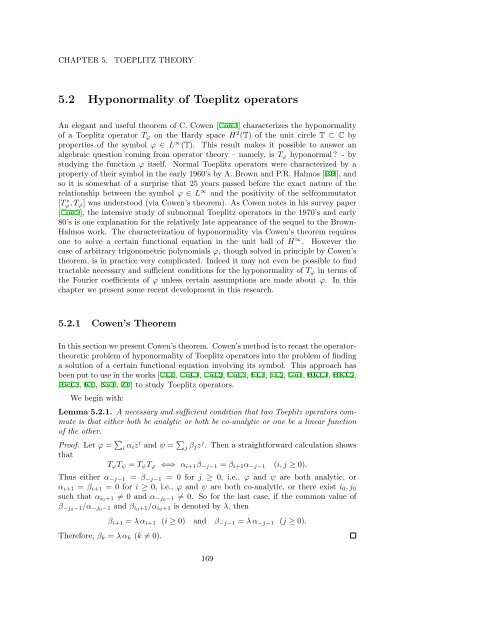Woo Young Lee Lecture Notes on Operator Theory
Woo Young Lee Lecture Notes on Operator Theory
Woo Young Lee Lecture Notes on Operator Theory
Create successful ePaper yourself
Turn your PDF publications into a flip-book with our unique Google optimized e-Paper software.
CHAPTER 5.<br />
TOEPLITZ THEORY<br />
5.2 Hyp<strong>on</strong>ormality of Toeplitz operators<br />
An elegant and useful theorem of C. Cowen [Cow3] characterizes the hyp<strong>on</strong>ormality<br />
of a Toeplitz operator T φ <strong>on</strong> the Hardy space H 2 (T) of the unit circle T ⊂ C by<br />
properties of the symbol φ ∈ L ∞ (T). This result makes it possible to answer an<br />
algebraic questi<strong>on</strong> coming from operator theory – namely, is T φ hyp<strong>on</strong>ormal - by<br />
studying the functi<strong>on</strong> φ itself. Normal Toeplitz operators were characterized by a<br />
property of their symbol in the early 1960’s by A. Brown and P.R. Halmos [BH], and<br />
so it is somewhat of a surprise that 25 years passed before the exact nature of the<br />
relati<strong>on</strong>ship between the symbol φ ∈ L ∞ and the positivity of the selfcommutator<br />
[Tφ, ∗ T φ ] was understood (via Cowen’s theorem). As Cowen notes in his survey paper<br />
[Cow2], the intensive study of subnormal Toeplitz operators in the 1970’s and early<br />
80’s is <strong>on</strong>e explanati<strong>on</strong> for the relatively late appearance of the sequel to the Brown-<br />
Halmos work. The characterizati<strong>on</strong> of hyp<strong>on</strong>ormality via Cowen’s theorem requires<br />
<strong>on</strong>e to solve a certain functi<strong>on</strong>al equati<strong>on</strong> in the unit ball of H ∞ . However the<br />
case of arbitrary trig<strong>on</strong>ometric polynomials φ, though solved in principle by Cowen’s<br />
theorem, is in practice very complicated. Indeed it may not even be possible to find<br />
tractable necessary and sufficient c<strong>on</strong>diti<strong>on</strong>s for the hyp<strong>on</strong>ormality of T φ in terms of<br />
the Fourier coefficients of φ unless certain assumpti<strong>on</strong>s are made about φ. In this<br />
chapter we present some recent development in this research.<br />
5.2.1 Cowen’s Theorem<br />
In this secti<strong>on</strong> we present Cowen’s theorem. Cowen’s method is to recast the operatortheoretic<br />
problem of hyp<strong>on</strong>ormality of Toeplitz operators into the problem of finding<br />
a soluti<strong>on</strong> of a certain functi<strong>on</strong>al equati<strong>on</strong> involving its symbol. This approach has<br />
been put to use in the works [CLL, CuL1, CuL2, CuL3, FL1, FL2, Gu1, HKL1, HKL2,<br />
HwL3, KL, NaT, Zh] to study Toeplitz operators.<br />
We begin with:<br />
Lemma 5.2.1. A necessary and sufficient c<strong>on</strong>diti<strong>on</strong> that two Toeplitz operators commute<br />
is that either both be analytic or both be co-analytic or <strong>on</strong>e be a linear functi<strong>on</strong><br />
of the other.<br />
Proof. Let φ = ∑ i α iz i and ψ = ∑ j β jz j . Then a straightforward calculati<strong>on</strong> shows<br />
that<br />
T φ T ψ = T ψ T φ ⇐⇒ α i+1 β −j−1 = β i+1 α −j−1 (i, j ≥ 0).<br />
Thus either α −j−1 = β −j−1 = 0 for j ≥ 0, i.e., φ and ψ are both analytic, or<br />
α i+1 = β i+1 = 0 for i ≥ 0, i.e., φ and ψ are both co-analytic, or there exist i 0 , j 0<br />
such that α i0 +1 ≠ 0 and α −j0 −1 ≠ 0. So for the last case, if the comm<strong>on</strong> value of<br />
β −j0−1/α −j0−1 and β i0+1/α i0+1 is denoted by λ, then<br />
β i+1 = λ α i+1 (i ≥ 0) and β −j−1 = λ α −j−1 (j ≥ 0).<br />
Therefore, β k = λ α k (k ≠ 0).<br />
169













